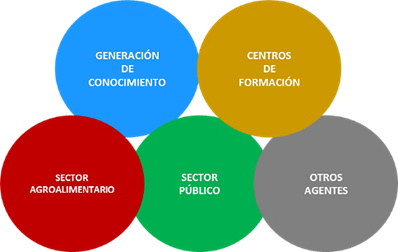Castile-La Mancha
Castilla-La Mancha has a long tradition and experience in the primary sector, which translates into its contribution of 10% of the Gross Value Added (GVA) of the agricultural sector in Spain. Its nearly 120,000 farms, with an average size of 33 hectares, share just over 4 million hectares of usable agricultural land ( European Commission (2024 ).
The contribution of La Mancha's primary sector to the regional and national economy is significant, thanks to the production of cereals, legumes, grapes, olives, and onions, among others. Livestock farming is primarily represented by sheep and goats, and to a lesser extent by cattle and pigs, with the region being the main producer of eggs nationwide. Finally, the agri-food industry accounts for around 40% of the regional manufacturing turnover, with the meat, dairy, and wine industries being particularly notable ( UNICAJA (2021). The Agricultural Sector and the Food Industry in Spain: Main Features and Regional Analysis in 2021 ).
The regional AKIS is represented by a cluster of public and private agents grouped together and interacting with each other:

The image shows the groups of public and private agents in a regional AKIS:
- Agents that generate knowledge.
- Public sector agents.
- Agents dedicated to training.
- Agents of the agri-food sector.
- Other AKIS agents.
AKIS agents and interactions
Agents dedicated to the generation of knowledge
- University of Castilla-La Mancha .
- Regional Institute for Agri-Food and Forestry Research and Development of Castilla-La Mancha ( IRIAF ): Public center focused on promoting research, innovation and development, as well as dissemination and technical advice, in the field of agriculture, livestock, agri-food industries and forestry. Linked to IRIAF are 8 specialized centers and institutes: Agroforestry Research Center ( CIAF ), Regional Center for Animal Selection and Reproduction ( CERSYRA ), Agro-Environmental Research Center ( CIAG ) "El Chaparrillo", Vine and Wine Institute of Castilla-La Mancha ( IVICAM ), Beekeeping and Agro-Environmental Research Center ( CIAPA ), Agricultural Research Center " Dehesón del Encinar ", CLaMbe r R&D Biorefinery for scaling up biotechnological processes, Viticulture and Oenology Station ( EVE ).
- Institute for Research in Hunting Resources ( IREC ): The Institute's mission is to generate and disseminate scientific knowledge that allows for a balance between hunting and conservation.
Public sector agents
- Ministry of Agriculture, Livestock and Rural Development : public institution that administers the responsibilities of agriculture, livestock, agri-food, rural development and fisheries in the Autonomous Community.
- Regional Agricultural Offices (45).
Agents dedicated to training
- Agricultural and vocational training schools. A list of institutes and centers can be found here .
Agents of the agri-food sector
- Agri-Food Cooperatives of Castilla-La Mancha.
- Professional Colleges of Agricultural Engineers , Agricultural Technicians and Veterinarians ( Albacete , Ciudad Real , Cuenca , Guadalajara , Toledo ).
- Professional Agricultural Organizations (OPAs): COAG-CLM , ASAJA Castilla-La Mancha and UPA Castilla-La Mancha .
Other Agents
- Castilian-Manchegan Rural Development Network ( RECAMDER ).
- Local Action Groups (29).
- Operational Groups .
- Science and Technology Park of Castilla-La Mancha .
Instruments and tools for the dynamization of the AKIS
REGIONAL SCIENCE, TECHNOLOGY AND INNOVATION STRATEGIES
For the period 2021-2027:
- Castilla-La Mancha Advances Plan. Regional Strategy for Recovery and Transformation 2021-2027 .
- Pact for the Economic Recovery and Employment of Castilla-La Mancha 2021-2024 .
- The Smart Specialization Strategy of Castilla-La Mancha 2021-2027 (Agri-Food Specialization Sector) .
CAP 2023-2027
Within the scope of the Common Agricultural Policy, Castilla-La Mancha allocates the following budget and actions to the three interventions most directly linked to the AKIS:
- 7161 (Cooperation of EIP operational groups): €10.8 million.
- 7201 (Knowledge sharing and information dissemination): €5.3 million.
- Courses and conferences: will include activities of Knowledge exchange and information dissemination in different formats, aimed at a specific group of participants, delivered in both theoretical and practical ways. Practical activities may include visits to farms, agri-food companies, and environmental services.
- Informative and demonstrative actions.
- Exchanges: Short stays on other EU farms or organized visits to them will allow participants to become directly involved in the learning process.
- 7202 (Advice): €3.7 million.
- Grants to help obtain advisory services.
- Grants for the creation of management, replacement and advisory services.
- Aid for the provision of tutoring services.
- List of Collaborating Agricultural Entities 2025
TOOLS FOR DYNAMIZATION
The importance of the agricultural sector in the economy of the Community and Spain, the climatic, demographic, economic and political circumstances, and current risks should stimulate investment and public-private partnerships through innovative projects and productive collaborations between large and small producers, processors, marketers, and researchers.
The revitalization of the regional knowledge and innovation transfer system (AKIS) is materialized in joint modernization and digitalization projects, scientific outreach conferences and events, technical and vocational training, economic missions, advice and publications in different formats and media to strengthen the competitiveness, adaptability and sustainability of the agricultural sector of Castilla-La Mancha and project it to other markets in addition to its net contribution to rural development and the environment. In this sense, "cooperation aims to integrate and improve relationships between the agents involved, whether producers, processors, public and private institutions, etc., thus facilitating the integration of research groups in order to innovate in primary production" ( European Commission (2024 ) as can be verified in the operational groups and innovative projects existing in the Community ( Viewer of Operational Groups and Innovative Projects of the RedPAC ).



